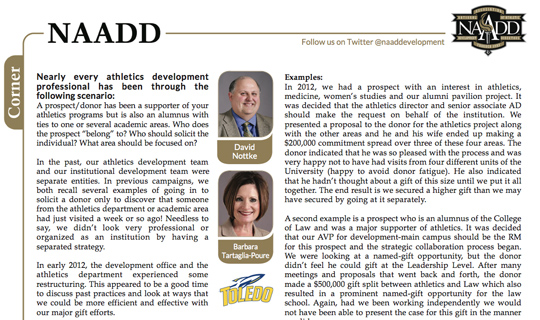When talking to a donor, The University of Toledo development offices have a collaborative system, which was described in a nationally published magazine article in June.
 Senior Associate Athletic Director David Nottke and Associate Vice President of Development Barbara Tartaglia-Poure co-wrote the article explaining the successful collaboration between the UT Athletic Development team and the Institutional Advancement development team when soliciting donors. It was published in the National Association of Athletic Development Directors’ monthly magazine.
Senior Associate Athletic Director David Nottke and Associate Vice President of Development Barbara Tartaglia-Poure co-wrote the article explaining the successful collaboration between the UT Athletic Development team and the Institutional Advancement development team when soliciting donors. It was published in the National Association of Athletic Development Directors’ monthly magazine.
The issues discussed in the article are problems that plague development offices at universities across the nation. Mainly, who is the appropriate contact from the university when a donor is interested in supporting a specific college or program that is important to them, as well as being interested in supporting the athletics programs?
“Nothing is more unprofessional looking to our supporters than having a development officer from one of our colleges go on a visit only to find out that a different development officer had visited that donor recently,” Tartaglia-Poure said. “It looks like one hand doesn’t know what the other is doing. So we created a new system that is donor-centric and it is working great at The University of Toledo.”
In early 2012, Nottke and Tartaglia-Poure had a series of discussions on how athletics and central development could work more effectively together. One of the key points of emphasis during these discussions was the collaboration of prospect management efforts. A major gifts officer for athletics was hired to assist with athletic fundraising goals. This individual works out the central Development Office with a reporting line to Tartaglia-Poure and a collaborative line to Nottke and the Athletic Department. This team approach has proven to be very beneficial to the University.
By collaborating, it makes it easier to connect a donor with the correct solicitor, Nottke explained. For example, if a donor was interested in giving to UT’s medical department and to athletics, Nottke felt the new structure of collaboration helped him to reach out to the appropriate individual that knew more about medicine. Working together as a team, they could decide who the appropriate person was to approach the donor and make a collaborative solicitation from both departments.
“At the end of the day, the donor drives the decision,” Nottke said. “The donors are going to tell us what they want to support. We have to be the facilitators to that support.”
Tartaglia-Poure said this process made the donors view UT as a more organized, professional body, which she believes has helped increase donations.
“On the outside looking in, they see The University of Toledo as one entity,” she said. “It puts us in a very professional light. It’s really increased collaboration.”
Nottke and Tartaglia-Poure said while it was great that they had the opportunity to share UT’s successful system with other universities in a national magazine, it’s all part of the job in their eyes.
“It is part of what we do,” Nottke said. “I think more than anything, it’s good for the University. It’s not necessarily about us; it’s that we work for The University of Toledo. It’s a team effort.”
To read Nottke and Tartaglia-Poure’s article, click here.